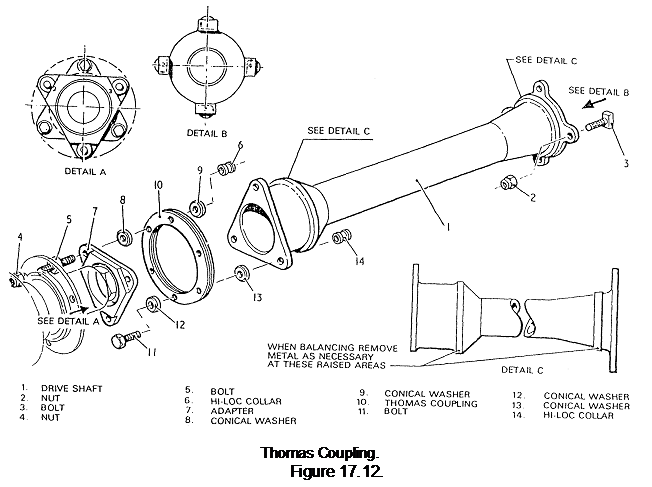Couplings:
Because of the requirement to make maintenance tasks such as engine removal/refit, gearbox removal/refit easier, it is necessary to have a means of coupling the turboshafts output shaft to the helicopter main rotor gearbox input shaft together. This coupling must possess qualities which will allow movement of both the engine and the rotor gearbox independently of each other i.e. it must be flexible. It must also be finely balanced to reduce vibration.
One of the most common couplings in use is the ‘Thomas Coupling', sometimes referred to as the engine ‘high speed drive shaft'. The engine is joined to the main rotor gearbox by this high speed drive shaft. The shaft is belled at either end , one end being attached to the power take off shaft by means of Thomas flexible steel coupling. Each coupling consists of a number of steel discs, indexed by flats to ensure correct alignment when assembled. Two different numbered discs are used, each disc having a grain running either parallel to the flat or perpendicular to the flat. The discs are assembled alternately with the grains at 90° to each other. The bolts, nuts and washers securing the shaft to the engine are part of the fine balancing of the assembly and must always be replaced in the same position.

Yet another method of coupling the engines power output to the main gearbox is shown in Figure.
The engine front mounting is bolted with the reduction gearbox to the hub of the air intake case; it supports the engine in the aircraft and serves as a torque reaction point. The mounting, which is of the gimbal type, is bolted to a gimbal ring, which is bolted to a similar mounting on the aircraft main gearbox, thus forming a gimbal coupling.
The engine output drive is transmitted to the aircraft main gearbox by a flanged coupling, which is secured via a flexible laminated disc coupling (Thomas Coupling) to a drive assembly. The drive assembly consists of an engine coupling and an aircraft main gearbox coupling bolted together, with a flexible laminated disc coupling (Thomas Coupling) at each end.